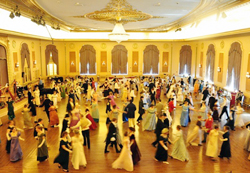This past weekend I was at a Regency Ball with my family for an afternoon of exquisite ballroom dancing (think Jane Austen, 1812). The ballroom is located in South Bend, IN, in a restored old building called the Palais Royale. With its tall ornate ceiling and beautiful wooden floor, it’s one stunning place!
At the ball, there was live music (piano, harp, and flute) and a “caller” who walked us through the dances. He used a handheld wireless microphone feeding a system with a number of ceiling loudspeakers placed throughout the space.
The loudspeakers seemed to be placed well enough to deliver adequate coverage, and their overall sound quality was fine. However, the majority of the time I found it difficult to understand what the caller was saying. Why did this happen?
1) The room was reverberant; the hard smooth surfaces of the floor, walls and ceiling acted as great reflectors of sound.
2) There was a lot of additional noise created by the participants.
3) I hate to admit it but my hearing isn’t what it used to be. (Ah, you can’t beat getting old!)
While I was struggling to understand what the caller was saying, my brain was pondering the real problem. I recalled something my good friend Vance Breshears (principal consultant at Acoustic Dimensions) said a little over a year ago: “acoustics can be simply defined as signal-to-noise ratio.”
In the ballroom, I could hear the caller (the signal), but at times the people and reflections (the noise) were interfering with the signal. What could I do to reverse this ratio?
First, and I might add, simply, I began joining sets of dancers that were close to the caller. I figured if I was able to get close enough to hear the acoustic sound of his voice, the signal would be stronger than noise.
Second, I worked to get myself positioned with “more mature” dancers, figuring they were probably having the same problem and would thus listen more intently and be quieter while the caller was talking.
My plan greatly helped, although being able to hear better did not mean I danced any better… :>)
I’m telling this story to get to this point: in your space, what is the noise? Is it the door at the back of the sanctuary that creaks, becoming horribly noticeable during the middle of the service? Is it the HVAC system that sounds like a wind tunnel when it fires up? Is it something simple, like the ushers forgetting to shut the doors to the lobby/narthex, allowing chatter and other unwanted sounds (footsteps, traffic noise outside the building, and so on) to drift in?
This Sunday, take a listen to the noise that interrupts the message (signal) and see what you can do to eliminate or at least minimize it. Sometimes things aren’t just about your system and mix.
Gary Zandstra is a professional AV systems integrator with Parkway Electric and has been involved with sound at his church for more than 25 years.


















